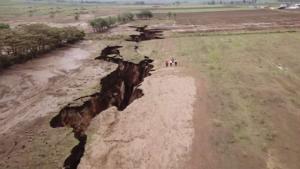A phenomenon of geological importance, requiring scientists to join hands to find out why.
Recently, social media sites have posted pictures of a large crack in the Rift valley area (Narok County, Kenya). As noted, the crack is 15m deep, 20m wide, and is getting longer and longer.
According to the Daily Nation, a geologist said the phenomenon happened because the area was inherently weak. Some of the cracks are new, but most of them have existed for a long time and are buried in volcanic ash. After recent heavy rains, the layer of ash washed away and revealed these terrible cracks.
The widespread fissure has greatly affected the residents living around the Rift valley. Many families had to be evacuated, including one house that was directly destroyed.
But what exactly is happening?
According to experts, this is not a new phenomenon, because this area is still… cracking very often.
In fact, eastern Africa is gradually being divided, due to the 5000km long tectonic plate running along the east side of the continent.

Eastern Africa is gradually being divided.
The African tectonic plate has split into the Somali and Nubian plates, forming a Y-shape, and they are separating from each other. This process, dubbed EARS (East African Fracture System), began slowly 25 million years ago, with a rate of only a few millimeters per year.
This also means that about 10 million years later, there will be a new ocean formed in the area left by East Africa.
Several theories have been put forward about EARS, the most prominent of which is that geological activities pushed chunks of superheated material to the surface, causing it to fracture. Although there is no conclusion, this is considered the most likely hypothesis.
Of course, such a phenomenon has many consequences. Some areas have shrunk over the past few million years, others have increased in size. The cleavage is so pronounced that it creates small-scale tectonic plates, such as the Victoria and Rovuma plates. Geological activity also created an underground volcanic system underground.
Similar cracks have also occurred in the past. In 2005, an 8m wide pit ran 60km in just 10 days. This fissure occurs because magma from the Dabbahu volcano (Ethiopia) flows underground, then cooled and pushed to the surface. And the reason it’s getting bigger is because of the operation of EARS.
Back to the rift from Kenya. According to many assessments, the cause is similar to the hole in Ethiopia – that is, because of active underground volcanoes. However, Dr James Hammond from the University of London disagrees.
“I don’t think it has anything to do with magma flows, it’s not like that. In Dabbahu, it’s not just a crack, it’s a collection of tectonic deformations,” he said.
“I also don’t know what the cause is? At that time, did anyone feel the tremor? If not, it is clear that the cause is not the volcano and the shifting geological plates.”

